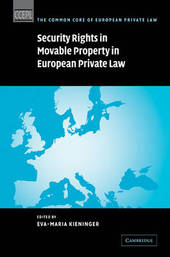
|
Security Rights in Movable Property in European Private Law
Paperback / softback
Main Details
Description
For every transnational lawyer, it is vital to know the differences between national secured transactions laws. Since the applicable law is determined by the place where the collateral is situated, it may change when movables are brought from one state to another. Introductory essays from comparative lawyers set the scene. The book then presents a survey of the law relating to secured transactions in the member states of the European Union. Following the Common Core approach, the national reports are centred around fifteen hypothetical cases dealing with the most important issues of secured transactions law, such as the creation of security rights in different business situations, the relationship between debtor and secured creditor, the nature of the creditor's rights and their enforcement as against third parties. each case is followed by a comparative summary. A general report evaluates the possibilities of European harmonisation in the field of secured transactions law.
Author Biography
Professor of German and European Private Law and Private International Law at Universitat Wurzburg, Germany.
Reviews'The volume is a profound comparative study which discusses the main problems of the European law of security rights in movable property in depth. ... The study ... is a valuable contribution to scholarship in the field of security law, but also to comparative property law in general. The neutral and descriptive approach of the study constitutes a good basis for further scholarly and political discussions on the harmonisation of security law. The case-orientated approach makes it also a good device for legal education. The volume thus can serve as a useful basis for a course or seminar on comparative property law. The picture that is drawn shows clearly that there is space and need for activity by the European Union.' Maastricht Journal of European and Comparative Law
|